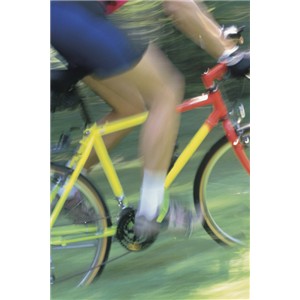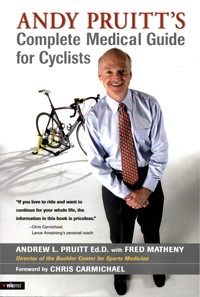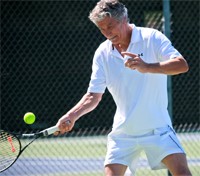|
Bicycling: Medical Aspects
Author:
Stan Reents, PharmD
Original Posting:
05/06/2007 06:18 AM
Last Revision: 11/04/2018 10:48 AM

Bicycling is a relatively safe and injury-free activity. Nevertheless, with an increase in time spent on a bike, certain cycling-related injuries will also increase. Several problems deserve mention. Here, we'll focus on the following injuries since they are largely preventable (Dannenberg AL, et al. 1996):
- head injuries
- wrist and hand problems
- lower back pain
- pelvic problems
- knee and leg problems
HEAD INJURIES
Do helmets reduce head injury? In a word: yes. One Australian study reports that helmets reduced the occurrence of head injury by 45% (McDermott FT, et al. 1993).
WRIST AND HAND PROBLEMS
If you ride for several hours continuously, chances are, your hands and wrists are going to get tired. It's possible you may even experience some finger numbness. The medical term for this is "compression neuropathy". It occurs frequently with long-distance riding but is seldom permanent (Richmond DR. 1994). For this, it's helpful to wear some gloves with gel pads in the palms. You can also add foam cushions to your handlebars. More serious riders will use elbow rests. Mostly, this is done to help lean the torso forward into a more streamlined position, but, it also takes weight off of your wrists and hands.
LOWER BACK PAIN
Low back pain from cycling has been reported in as many as 50% of riders (Salai M, et al. 1999). One simple solution to this problem is to change the angle of the seat. Tipping the front of the seat downward by a mere 10-15 degrees improved low back pain in 70% of riders (Salai M, et al. 1999). Another possible solution is to switch from a standard seat to a modified seat (eg., one with a groove cut down the center, or, one with no nose) (Bressel E, et al. 2003).
PELVIC PROBLEMS
Studies show that 35-81% of riders experience perineal and/or buttock pain after long-distance riding. This appears to be a more frequent complaint from women as opposed to men riders (Bressel E, et al. 2003).
The high incidence of these medical problems shouldn't be surprising: Pressures generated in the perineum (groin) region while sitting on a bicycle seat can be 4-5-fold higher than pressures known to cause decubitus ulcers (commonly known as "pressure sores") (Lowe BD, et al. 2004).
Sitting on a bicycle seat has been shown to drastically reduce blood supply to the penis. In one study, sitting on a bicycle seat decreased blood flow by 70%. It made no difference whether the riders were sitting and pedalling or just sitting. Blood flow was back to normal after a 10-minute recovery period (Sommer F, et al. 2001a).
Higher pressures in the perineal region also irritate the pudendal nerve (Oberpenning F, et al. 1994), possibly leading to pudendal neuropathies. Competitive cyclists have developed numbness of the penis and scrotum, an altered sense of ejaculation, and disturbances of normal urinary function after prolonged cycling (Silbert PL, et al. 1991).
How Long Does it Take for Pelvic Problems to Appear?
As summarized above, it only takes several minutes of sitting on a bicycle seat to impair blood flow. This appears to be mostly reversible within several minutes after getting off the bike. But, what about the development of erectile dysfunction (impotence)?
Some research provides insight into how many miles of biking leads to erectile dysfunction (ED):
• In an evaluation of 40 healthy cyclists (average age: 30 +/- 5.3 yrs), 19% who had a training distance of more than 400 km per week reported erectile dysfunction (Sommer F, et al. 2001b). At a relatively moderate pace of 15 km/hr, this is equivalent to almost 4 hours of riding per day, 7 days per week....much more than the average weekend warrior rides.
• Data from the Massachusetts Male Aging Study (MMAS) show that bicycling more than 3 hrs per week was associated with ED (Marceau L, et al. 2001).
Obviously, the data from these 2 studies are widely divergent. Variables like seat design, rider's body weight, how often the rider gets off the seat while riding, etc. all affect the determination of any kind of riding limit.
Addressing Pelvic Problems From Cycling
What can be done about pelvic problems? In some cases, the symptoms will resolve if you stop biking:
• Pudendal neuritis: With regards to pudendal neuritis, one case resolved after 4 weeks and another resolved at 7 weeks (Oberpenning F, et al. 1994).
• Impotence: Of 160 riders in the Norwegian annual bicycle race of 540 km, 13% reported impotence. For 3 of these riders, the impotence lasted more than 1 month (Andersen KV, et al. 1997). Impotence, however, may not be reversible. If blood flow to the penis has been depressed over many months, then a condition known as penile fibrosis may have developed.
Other strategies include:
Seat Design:
Some (but not all) studies show that pressures in the perineal region are higher when sitting on a "standard" bicycle seat design compared to seats with a groove down the center (Taylor KS, et al. 2002), or seats without a nose (Lowe BD, et al. 2004). As mentioned earlier, higher pressures in the perineal region in turn lead to vascular and neurologic problems. However, seats without a protruding nose can lead to more weight being shifted onto the wrists and a sense of less ability to steer and handle the bike (Bressel E, et al. 2003).
Perhaps a better solution is to use a wider seat. One study showed that pressures in the perineal region were highest when seat width was 5.5-7.5 cm. Seats wider than 9.5 cm produced the lowest pressures (Spears IR, et al. 2003).
Cycling While Standing
Standing up while cycling alleviates the compression of the pelvic vessels. Blood flow to the penis during cycling while standing is actually higher than standing while at rest. In this study, blood flow improved after only 1 minute of cycling while standing (Nayal W, et al. 1999). Thus, if you are on a long bike ride, get off the seat for several minutes during every 15-minutes of riding.
Lower Weekly Mileage
According to one study, keeping your time on the bike to less than 3 hrs per week may help to prevent ED (Marceau L, et al. 2001).
KNEE AND LEG PROBLEMS
The knees and the legs really get a work-out during long bike rides. During 1 hour of cycling, even an average rider may produce 5000 pedal revolutions. Analysis of the world's elite cyclists during races like the Tour de France reveal a pedal cadence of roughly 90 per minute on flat terrain and roughly 70 pedals per minute during hill-climbing (Lucia A, et al. 2001). And these riders maintain that pace 6 hours per day for 3 weeks! Multiply it all out and you get well over a half-million pedal revolutions during the entire Tour de France.
Therefore, it should come as no surprise that knee pain is the most common lower-extremity overuse problem in cyclists. Studies of recreational cyclists show that 42-65% of riders report knee pain. Heavy training loads and high mileage, along with a rapid increase in intensity too early in the training program contribute to overuse injuries (Asplund C, et al. 2004).
Another problem common with cyclists is iliotibial band (ITB) syndrome. The iliotibial band is a thick, fibrous band that extends down the outside of the leg from the hip to the knee. This syndrome is characterized by sharp or stabbing pain on the outside of the knee (Asplund C, et al. 2004).
Preventing Knee and Leg Pain
The most important factor in preventing knee or leg pain during cycling is seat height. If the seat is too low, too much stress is placed on the knee by the patellar and quadriceps tendons. A seat that is too high, or too far back, forces the rider to extend his/her leg too far during each pedal stroke. This irritates the iliotibial band (ITB), and can lead to ITB syndrome.
The best seat location is one that produces about 25-30 degrees of angle at the knee when the pedal for that leg is in the 6 o'clock position. If the leg extends to its full length, or, if the hips rock from side-to-side as you pedal, then your seat is too high.
DEHYDRATION AND HYPONATREMIA
Dehydration may be underestimated by some riders. Because the wind evaporates sweat from the body more rapidly than when running, riders may not think they have perspired very much. But dehydration was a common finding in recreational cyclists during a 6-day, 339-mile ride across Maryland (Dannenberg AL, et al. 1996). Ironically, cyclists may also be at a higher risk of developing hyponatremia since it is easier for them to drink while competing than it is for athletes in other sports. (see the related story "Fluids and Electrolytes During Exercise".)
QUESTIONS
Q: Do recumbent bicycles reduce the risk of these cycling injuries?
ANSWER: Not much research has been done to evaluate this, but, certainly, it would seem that hand/wrist problems, and pelvic problems would occur less often when riding a recumbent bike as compared to a traditional road bike.
SUMMARY
Despite some of the medical problems discussed above, don't let these issues stop you from biking...these risks are surely more than offset by the health gains and enjoyment you will get.
As you do more biking, keep the following in mind:
• Training: To minimize the occurrence of knee and leg soreness, build-up your mileage gradually. Stand-up often on long rides to allow blood flow to return to normal in the pelvic area.
• Hydration: Sweat evaporates more rapidly when you ride than when you run, so you can be misled into thinking that you haven't lost very much body water. However, it is important to drink regularly when you ride. But make sure your rehydration beverage has some sodium in it.
• Helmet: Wear one. They work. If you want to ride in organized rides or races, a helmet is often a requirement for participation.
• Seat: Even though there is still some controversy on the relationship between seat design and impotence in cyclists, I recommend that men get a seat with a mid-line groove. Women, because they often have wider hips than men, should get a seat designed for them.
 FOR MORE INFORMATION FOR MORE INFORMATION
The web site www.BikeFitting.com has some helpful discussions on medical problems that arise when your bike isn't the right size for your anatomy. Click on "FAQ". A great web site for resources on promoting bike safety, and for information on bicycling is: www.BicyclingInfo.org.
Andy Pruitt is considered the authority on bike fitting. His book "Complete Medical Guide for Cyclists" is an excellent resource on sports medicine issues for cyclists. Read our review... Readers may also be interested in the following related stories:
EXPERT HEALTH and FITNESS COACHING
Stan Reents, PharmD, is available to speak on this and many other exercise-related topics. (Here is a downloadable recording of one of his Health Talks.) He also provides a one-on-one Health Coaching Service. Contact him through the Contact Us page.
REFERENCES
Andersen KV, Bovim G. Impotence and nerve entrapment in long distance amateur cyclists. Acta Neurol Scand 1997;95:233-240. Abstract
Asplund C, St. Pierre P. Knee pain and bicycling. Phys Sportsmed 2004;32:23-30. (no abstract)
Bressel E, Larson BJ. Bicycle seat designs and their effect on pelvic angle, trunk angle, and comfort. Med Sci Sports Exerc 2003;35:327-332. Abstract
Burgomaster KA, Hughes SC, Heigenhauser GJ, et al. Six sessions of sprint interval training increases muscle oxidative potential and cycle endurance capacity in humans. J Appl Physiol 2005;98:1985-1990. Abstract
Dannenberg AL, Needle S, Mullady D, et al. Predictors of injury among 1638 riders in a recreational long-distance bicycle tour: Cycle Across Maryland. Am J Sports Med 1996;24:747-753. Abstract
Lowe BD, Schrader SM, Breitenstein MJ. Effect of bicycle saddle designs on the pressure to the perineum of the bicyclist. Med Sci Sports Exerc 2004;36:1055-1062. Abstract
Lucia A, Hoyos J, Chicharro JL. Preferred pedalling cadence in professional cycling. Med Sci Sports Exerc 2001;33:1361-1366. Abstract
Marceau L, Kleinman K, Goldstein I, et al. Does bicycling contribute to the risk of erectile dysfunction? Results from the Massachusetts Male Aging Study (MMAS). Int J Impot Res 2001;13:298-302. Abstract
McDermott FT, Lane JC, Brazenor GA, et al. The effectiveness of bicyclist helmets: a study of 1710 casualties. J Trauma 1993;34:834-844. Abstract
Nayal W, Schwarzer U, Klotz T, et al. Transcutaneous penile oxygen pressure during bicycling. BJU Int 1999;83:623-625. Abstract
Oberpenning F, Roth S, Leusmann DB, et al. The Alcock syndrome: temporary penile insensitivity due to compression of the pudendal nerve within the Alcock canal. J Urol 1994;151:423-425. Abstract
Richmond DR. Handlebar problems in bicycling. Clin Sports Med 1994;13:165-173. Abstract
Salai M, Brosh T, Blankstein A, et al. Effect of changing the saddle angle on the incidence of low back pain in recreational bicyclists. Br J Sports Med 1999;33:398-400. Abstract
Silbert PL, Dunne JW, Edis RH, et al. Bicycling induced pudendal nerve pressure neuropathy. Clin Exp Neurol 1991;28:191-196. Abstract
Sommer F, Schwarzer U, Klotz T, et al. Erectile dysfunction in cyclists. Is there any difference in penile blood flow during cycling in an upright versus a reclining position? Eur Urol 2001a;39:720-723. Abstract
Sommer F, Konig D, Graft C, et al. Impotence and genital numbness in cyclists. Int J Sports Med 2001b;22:410-413. Abstract
Spears IR, Cummins NK, Brenchley Z, et al. The effect of saddle design on stresses in the perineum during cycling. Med Sci Sports Exerc 2003;35:1620-1625. Abstract
Taylor KS, Richburg A, Wallis D, et al. Using an experimental bicycle seat to reduce perineal numbness. Phys Sportsmed 2002;30:27-32. (no abstract)
ABOUT THE AUTHOR

Stan Reents, PharmD, is a former healthcare professional. He is a member of the American College of Lifestyle Medicine (ACLM) and a member of the American College of Sports Medicine (ACSM). In the past, he has been certified as a Health Fitness Specialist by ACSM, as a Certified Health Coach by ACE, as a Personal Trainer by ACE, and as a tennis coach by USTA. He is the author of Sport and Exercise Pharmacology (published by Human Kinetics) and has written for Runner's World magazine, Senior Softball USA, Training and Conditioning and other fitness publications.
Browse By Topic:
aerobic exercise, back pain, bicycle seats, bicycles, sports medicine, triathlon
Copyright ©2026 AthleteInMe,
LLC. All rights reserved.
|